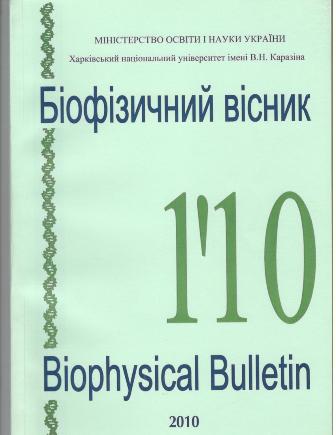Пошук мінімумів енергії взаємодії комплексів комплементарніх ланцюгів ДНК у промоторних і кодуючих частинах генів E. coli
Анотація
Проведено комп'ютерний аналіз нуклеотидного складу та енергії взаємодії ланцюгів ДНК в промоторних і кодуючих ділянках генів E. сoli. Було показано збільшення вмісту тиміну і аденіну в зоні промотора. Значних відмінностей між генами в прямій і зворотній орієнтації не виявилено. Виявлені мінімуми енергії взаємодії комплементарних ланцюгів ДНК в прямій і зворотній орієнтаціях в промоторних і кодуючих областях генів E. сoli поблизу наступних позицій: -100, -70, -40, +5, +20, +30. Сайти -40, +5 близьки до відомих консенсусних послідовностей нуклеотидів в промоторі, що впливають за активність гена. Ділянки: -100, -70, +20, +30, за нашими даними, також мають знижену енергію взаємодії комплементарних ланцюгів ДНК, що дозволяє припустити, що вони мають регуляторний значення. Енергія взаємодії комплементарних ланцюгів ДНК знижена не тільки в області промотора, а й на початку кодуючої частини гена. Зростання в енергії взаємодії ДНК в кодуючої частини гена спостерігається після 100-й позиції. Енергія взаємодії ланцюгів ДНК нижче в зворотних, ніж у прямих послідовностях. Відмінності між прямими та зворотними послідовностями статистично достовірні в області від -150 до - 101 та від 1 до 51. Гени у зворотній орієнтації мають додаткові мінімуми енергій в позиціях: -140, -120, - 25 і +40. Крім того, в генах зі зворотним орієнтацією є мінімум енергії взаємодії ланцюгів ДНК в області -85, в той час, як у генах з прямою орієнтацією мінімум енергій є в області -80.
Завантаження
Посилання
2. Morton R.A., Morton B.R. Separating the effects of mutation and selection in producing DNA skew in bacterial chromosomes. BMC Genomics 2007; 8: 369.
3. Lobry J.R., Sueoka N. Asymmetric directional mutation pressures in bacteria. Genome Biol. 2002; 3(10): research0058.1–research0058.14.
4. Mrazek J., Karlin S. Strand compositional asymmetry in bacterial and large viral genomes. Proc. Natl. Acad. Sci. USA. 1998; 178: 3720-3725.
5. Rocha C. The replication-related organization of bacterial genomes. Microbiology 150 2004; 220: 1609-1627.
6. Tillier E.R., Collins R.A. Replication orientation affects the rate and direction of bacterial gene evolution. J Mol. Evol. 2000; 51(5): 459-63.
7. Burland V., Plunkett G., Daniels D.L., Blattner F.R. DNA sequence and analysis of 136 kb of the Escherichia coli genome: organizational symmetry around the origin of replication // Genomics. 1993. V. 16: 551–561.
8. Ogasawara N., Yoshikawa H. Genes and their organization in the replication origin region of the bacterial chromosome // Mol. Microbiol. 1992. V. 6. P. 629–634.
9. Kunst, F., Ogasawara, N., Moszer, I. & 148 other authors. The complete genome sequence of the Gram-positive bacterium Bacillus subtilis // Nature 1997. V. 390. P.249–256.
10. Blattner F.R., Plunkett G., Bloch C.A. & 14 other authors. The complete genome sequence of Escherichia coli K-12 // Science. 1997. V. 240. P. 1453-1461.
11. Dervyn E., Ehrlich S.D. Two essential DNA polymerases at the bacterial replication fork. Science. 2001. V. 294. P. 1716-1719.
12. Yuzhakov, A., Turner, J. & O'Donnell, M. Replisome assembly reveals the basis for asymmetric function in leading and lagging strand replication // Cell. 1996. V. 86. P. 877–886.
13. Sponer J., Jurecka P., Hobza P. Accurate interaction energies of hydrogen-bonded nucleic acid Base Pairs // J. AM. CHEM. SOC. 2004. V. 126. P. 10142-10151.
14. Rocha E.P., Danchin A., Viari A. Universal replication biases in bacteria // Mol. Microbiol. 1999. V.32. P. 11–16/
Автори, які публікуються у цьому журналі, погоджуються з наступними умовами:
- Автори залишають за собою право на авторство своєї роботи та передають журналу право першої публікації цієї роботи на умовах ліцензії Creative Commons Attribution License, котра дозволяє іншим особам вільно розповсюджувати опубліковану роботу з обов'язковим посиланням на авторів оригінальної роботи та першу публікацію роботи у цьому журналі.
- Автори мають право укладати самостійні додаткові угоди щодо неексклюзивного розповсюдження роботи у тому вигляді, в якому вона була опублікована цим журналом (наприклад, розміщувати роботу в електронному сховищі установи або публікувати у складі монографії), за умови збереження посилання на першу публікацію роботи у цьому журналі.
- Політика журналу дозволяє і заохочує розміщення авторами в мережі Інтернет (наприклад, у сховищах установ або на особистих веб-сайтах) рукопису роботи, як до подання цього рукопису до редакції, так і під час його редакційного опрацювання, оскільки це сприяє виникненню продуктивної наукової дискусії та позитивно позначається на оперативності та динаміці цитування опублікованої роботи (див. The Effect of Open Access).





